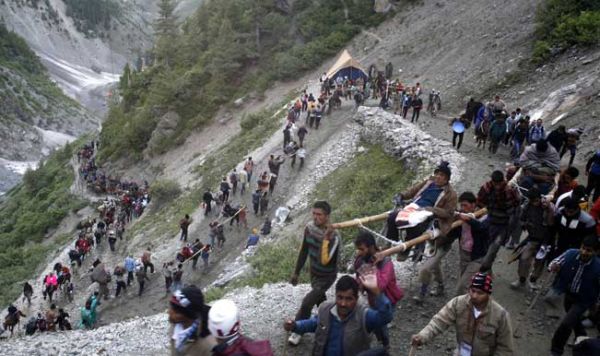By: Muskaan Rafiq
A local Anantnag ponywala named Abdul helped Ravi navigate the steep trails, carried his bag, offered him tea in the rain, and supported him when altitude sickness set in. Ravi had come searching for Lord Shiva but found something just as divine: boundless humanity. The Amarnath Yatra, one of India’s most revered pilgrimages, draws lakhs of devotees every year. The trek to the cave shrine is physically gruelling, winding through rugged terrain and unpredictable weather at high altitudes. But behind every successful journey lies the silent, often unseen support of the local Kashmiri people, many of them Muslim, living in villages like Pahalgam, Baltal, and Chandanwari.
These locals are not just bystanders. They are the scaffolding that holds up the entire yatra. They carry the elderly, navigate dangerous slopes, set up tents, and often put their own comfort and safety aside for the sake of the yatris. When natural disasters strike, landslides, flash floods, snowstorms, they are often the first responders, arriving well before any official help. And it is not just physical help. Their contribution runs deep. Whether it is offering hot kahwa in freezing rain, guiding lost pilgrims, or sitting quietly beside someone who is sick, their compassion leaves a lasting mark. For many Kashmiri families, the yatra is also a vital economic lifeline. Over the course of the yatra season, their earnings sustain them through long winters when tourism dries up. Shops selling gloves, raincoats, and trekking gear pop up along the trail. Families rent out rooms, cars, and tents. Women run small dhabas offering hot rotis and dal. These are not just business transactions; they are exchanges wrapped in care and hospitality.
In many ways, this pilgrimage is a mutual contract. Pilgrims seek divine blessings, and locals offer not just services, but solidarity. Many of their contributions go unpaid and unnoticed. In 2022, during flash floods near the cave, it wasn’t just Army rescue teams who jumped into action. Local villagers ran barefoot into icy water, formed human chains, and took stranded yatris into their homes. Young men helped carry the injured. Elderly women fed and warmed those who were freezing. No cameras. No announcements. Just quiet action. Langars, the communal kitchens, are a major part of the Yatra experience. While most are organized by Hindu groups, it is common to see Kashmiris donate milk, firewood, or even serve as cooks. In remote spots like Panchtarni and Chandanwari, Kashmiri families often offer food and chai for free to those who cannot afford it. Mehman-Nawazi, or hospitality, is not performative in Kashmir. It is cultural. Pilgrims return with more than just photos of the Lingam. They return with stories of kindness from people who may not share their religion but deeply share their humanity. These are not rare incidents. They happen every year. In Domail, during a sudden hailstorm, local boys handed out blankets and food before any official help arrived. In 2019, a porter named Fayaz Ahmad carried a sick pilgrim on his back for nearly three kilometers to reach a medical camp. In Pahalgam, a Muslim family has hosted the same group of Hindu yatris in their home every year since 2005.
These are the real stories of the Yatra. Stories that don’t make it to prime-time news. Stories that show Kashmiris not as outsiders, but as protectors, companions, and quiet heroes of this spiritual journey. Thankfully, some official bodies have begun to recognize their importance. The Shri Amarnath Shrine Board now provides porters and workers with insurance, training, and emergency assistance. But more should be done. Local contributions should be celebrated in the media. Yatris can be encouraged to offer gifts or messages of gratitude. Volunteers who risk their lives should be eligible for honors, healthcare benefits, and support beyond the yatra season.
Because the truth is, the sacredness of the Yatra lies not just in the ice lingam but in the journey itself, and in the people who make that journey possible. The divine isn’t only found in chants and caves. It is also found in the cup of kehwa offered in the rain, in a blanket handed to a shivering pilgrim, or in the ponywala walking beside you in silence. You won’t understand this by watching a debate on TV. You will understand it in Baltal, during a downpour, when a teenage boy gives you his only dry blanket. You will see it in Panchtarni, where a ponywala carries an old man uphill without a single complaint. Or near Sheshnag, when you are lost and a stranger appears out of nowhere, leads you back to safety, and disappears without even asking for money.
These moments are not acts of performance. They are part of everyday life during the yatra, simple gestures by people whose warmth is greater than any mountain you will cross. This generosity comes from a region that has seen decades of conflict, instability, and political tension. Yet, every year during the Yatra, locals rise above all of it. They don’t ask who you vote for or which god you worship. They ask if you are tired, if you are cold, if you need help. This is Kashmiriyat. Not as a slogan, but as a lived reality.
And let’s not forget the women. While ponywalas and porters are visible, behind the scenes are mothers, wives, and sisters who prepare meals, boil water, make quilts, and wake early to support this sacred passage. They often go unacknowledged in official reports, yet their work shapes the yatris’ experience just as much as any formal arrangement. The Yatra has become a mirror. Pilgrims who arrive with uncertainty often leave with changed hearts. They see a young Muslim boy rescue a Hindu elder from a ravine. They are handed extra biscuits by a chaiwala who expects nothing back. They are offered shelter by villagers who have little to give, yet still give more than most. These moments plant seeds of understanding, of unity, of connection across divides. And while most of the world might miss them, the yatris don’t. These memories stay. They return home and share them, adding depth to our national conversation about Kashmir and Kashmiris.
But too often, these heroes fade into the background once the Yatra ends. Porters, chaiwalas, Dhaba owners, guides, they return to daily life without recognition. And yet they show up again the next year, with the same humility and quiet strength.
It is time we change that. Authorities can regulate wages, offer insurance, and invest in education for their children. The media can shift focus, from suspicion to solidarity, from division to dignity. Pilgrims can do their part too. Not just by saying thanks, but by sharing these stories, changing perspectives, and spreading awareness. Because at its core, the Amarnath Yatra is not just a walk to a shrine, it is a walk with people who remind us what it really means to be human. The divine is not always found in stone or ice. Sometimes it is in the rough hand offering you a rope. Sometimes it hums in the voice of a Kashmiri woman calming a child during a snowstorm. Sometimes it glows in a fire lit with a shared matchstick.
The writer is a columnist and often writes on Kashmir’s social issues. She can be reached at muskaanrafiq173@gmail.com





